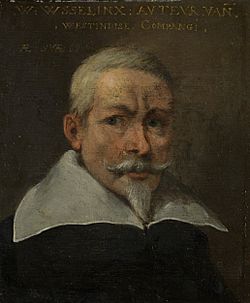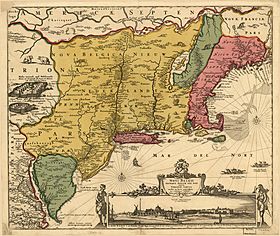Willem Usselincx facts for kids
Quick facts for kids
Willem Usselincx
|
|
|---|---|

Willem Usselincx, 1637
|
|
| Born | 1567 |
| Died | c. 1647 (aged 79–80) |
| Occupation | Merchant |
| Known for | Founder of the Dutch West India Company |
| Signature | |
Willem Usselincx (born in 1567, died around 1647) was a Flemish Dutch merchant. He was also an investor and a diplomat. He played a big part in getting both the Dutch and Swedish people interested in exploring and settling the New World (the Americas). Usselincx is known as a founder of the Dutch West India Company.
Contents
Willem Usselincx's Early Life
Usselincx was born in Antwerp, which is now part of Belgium. This was a time of huge changes and wars. His life happened during the Eighty Years' War (1568–1648). This war was when the Dutch fought for their freedom from Spain. It led to seven provinces becoming the Dutch Republic.
When Usselincx was born, Antwerp was a very important port in Western Europe. It was a rich city and one of the biggest in Europe north of the Alps.
Changes in Antwerp
A big religious change called the Protestant Reformation caused riots in Antwerp in 1566. Soon after, the Eighty Years' War began. The Spanish king managed to take back parts of the southern areas like Flanders and Brabant.
In 1579, Antwerp joined a group called the Union of Utrecht. It became a main city for the Dutch fight against Spain. But in 1585, the Spanish army captured Antwerp after a long fight. As part of the surrender, Protestant citizens had to leave the city within four years.
Many people left Antwerp and moved north to the Dutch Republic. This move helped the Dutch Republic become very rich and powerful. This time is known as the "Dutch Golden Age". Amsterdam became the new center for trade. Its population grew a lot, and new canals were built to welcome traders from Antwerp. The southern parts of the Netherlands became known as the Spanish Netherlands.
The Dutch West India Company

Usselincx had traveled to Spain, Portugal, and the Azores islands. There, he saw how much wealth Spain and Portugal gained from their colonies. After the Spanish took Antwerp in 1585, Usselincx moved to the Dutch Republic. He lived first in Middelburg and then in Amsterdam. He strongly believed that the Netherlands would win its freedom. He also thought they should take colonies from Spain and Portugal.
In 1608, he wrote a book called Naerder Bedenckingen. In this book, he argued for setting up a West India trading company. He often talked about how powerful Spain was and how much wealth it got from the West Indies.
In 1621, Usselincx was one of the founders of the Dutch West India Company. He had been planning this company for many years. His goals were not just about making money. He hoped to create a new and better society in the Americas. He wanted thousands of Protestants to move there. He didn't just want to take resources from the land. Instead, he wanted to build a new country, which became New Netherland. However, the Dutch government did not fully support this second goal.
The Swedish South Company
Usselincx also helped Peter Minuit get Sweden interested in starting a colony. This colony later became New Sweden. Like Usselincx, Peter Minuit had been disappointed by the Dutch West India Company. He was even replaced as the governor of New Amsterdam.
As early as 1626, Usselincx had told Sweden about the benefits of an overseas adventure. He mentioned the wealth Spain and the Netherlands had gained from their colonies. He also praised Sweden's resources for success in trade. King Gustavus Adolphus of Sweden gave Usselincx special permission to start a trading company. The king asked Usselincx to raise money for the Swedish South Company by selling shares in Sweden.
Usselincx moved from the Netherlands to Sweden. But starting the new company was hard and took a long time. This was true even with the support of Axel Oxenstierna, a powerful Swedish leader. The company's plan included Swedish, Dutch, and German investors. These investors were led by the directors of the New Sweden Company.
In 1637, Minuit worked with Samuel Blommaert and the Swedish government to create New Sweden. This was the first Swedish colony in the New World. But by this time, Usselincx had lost most of his money due to bad investments. He could not benefit from his great idea. Between 1638 and 1655, the company sent 11 trips to Delaware.
In 1649, the Swedish South Company lost its special right to trade tobacco. This right had been given by the king in 1641. In 1655, New Sweden became part of New Netherland. This ended the activities of the Swedish South Company, and it closed in 1680.
The Swedish East India Company was not started until 1731. Its purpose was to trade with countries far to the east.


